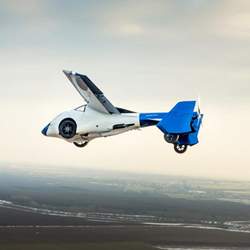
For a motorist stuck in mind-numbing traffic, the idea of hopping, skipping, and jumping over gridlock is nothing less than captivating. Yet despite the widespread fantasy of piloting a flying car—something akin to those depicted in the 1960s TV show The Jetsons—technical and practical challenges so far have kept the concept grounded.
Yet times and technologies change. Personal Air Vehicles (PAVs) may soon be coming to the skies overhead.
"The idea of personal flying vehicles isn't new, but it is moving forward," says Sanjiv Singh, research professor at Carnegie Mellon University's Robotics Institute. "We also are witnessing rapid advances in electric propulsion and other technologies that make this concept more feasible."
Consider: ride-sharing firm Uber hopes to introduce a fleet of flying taxis over Dallas and Dubai by 2020. Kitty Hawk—a firm backed by Google co-founder and Alphabet Inc. CEO Larry Page—recently debuted a craft in a demonstration flight. A German startup, Lilium, has successfully tested a two-seat air vehicle that uses two wings and 36 turbofans to move vertically and horizontally at a top speed of 150 miles per hour.
Says Mary Cummings, director of Duke University's Humans and Autonomy Lab, "We've reached a point where private firms believe it's possible to produce personal air vehicles that would be affordable and available on demand. Whether they can transform the idea into a commercial success remains to be seen."
The Sky's the Limit
Although dreams of traversing the skies in a personal aircraft have been floating around for centuries, the modern concept emerged in 2003, when the U.S. National Aeronautics and Space Administration (NASA) launched the Personal Air Vehicle Sector Project. The goal? Produce breakthroughs that would lead to new types of aircraft for terrestrial transportation. NASA defined PAVs as quiet, comfortable, affordable, reliable machines that hold up to five passengers, travel at up to 200 miles per hour, tap synthetic vision for near all-weather capabilities, and provide "door-to-door" transportation.
Only recently have engineering and computation advanced to the point where personal aircraft are feasible, however. More than a dozen companies are now developing PAVs.
Lilium's vehicle incorporates a high-speed electric motor running on a one-hour rechargeable battery to propel the craft at a top speed of over 150 miles per hour. The company plans to introduce a commercially available version that accommodates five people.
Uber's aircraft relies on electric propulsion to power a piloted PAV that would serve as a taxi transport within cities. This, the company claims, would reduce two-hour car commutes to 15 minutes or less, at a cost only moderately above today's fares. "On-demand aviation has the potential to radically improve urban mobility, giving people back time lost in their daily commutes," the company noted in a 2016 white paper.
Martin Henz, an associate professor in the School of Computing at the National University of Singapore (NUS), has worked with students to develop a vertical take-off and landing (VTOL) aircraft dubbed Snowstorm that incorporates motors, propellers, and inflatable landing gear . The aircraft is controlled by a single person seated within it. Says Henz, "The technology has reached a point where PAVs are technically feasible. But there are many other issues to grapple with."
PAVs Take Flight
If personal air vehicles take off, there would be a need for new infrastructure, including airports or vehicle ports. Uber describes these facilities as "vertiports," small landing pads that support vertical take-off and landing. There would also be a need for air traffic control systems, established flight patterns and, at least over the short term, trained pilots. The long-term goal of making such flying vehicles autonomous would require further advances in sensing and other technologies.
Singh says these systems, like today's aircraft and emerging autonomous automotive vehicles, will require numerous sensors and redundant systems. "To reach an automated state, there will be a need for artificial intelligence to understand complex real-world situations such as power lines, drones, or when a problem exists with the landing spot."
Henz believes PAVs, for the foreseeable future, will be limited largely to ambulances, police vehicles, sightseeing, and amusement park rides (an idea he has promoted). Battery limitations create huge challenges. What's more, "The idea of simply moving vehicles from the ground to the air to alleviate transportation problems is a bit preposterous," he argues.
Concludes Singh, "It's still a tall order to produce vehicles that are inexpensive, fast, and safe. There are formidable challenges associated with transforming the technology into a viable business model and achieving the economies of scale required to make these vehicles something that's used widely."
Samuel Greengard is an author and journalist based in West Linn, OR.



Join the Discussion (0)
Become a Member or Sign In to Post a Comment